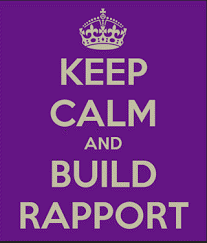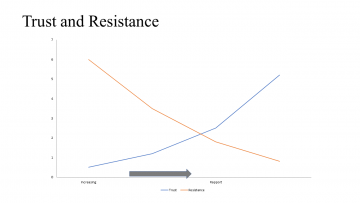
“Rapport is the ability to enter someone else’s world, to make him feel that you understand him, that you have a strong common bond.”
–Tony Robbins
This is the last in a series of three blogs on the intricacies and application of rapport to the interview process. They will address why rapport is foundational and essential to success in maximizing the quality and quantity of truthful information obtained during interviews. They aren’t a complete anthology of all thing’s rapport, but useful snippets to cause you to pause as you plan for rapport in your next interview.
In the first blog we examined the three levels of rapport; casual, close, and intimate, and our need to traverse those levels to effectively develop a relationship to maximize the quality and quantity of truthful information we receive in the interview.
The second blog addressed the 7 foundational requirements for rapport. Rapport begins immediately; it conditions the interviewee to talk; it allows us to establish a behavioral baseline; it establishes trust and credibility (if done well); it must be re-emphasized if reserved or hostile; we should establish it with all to whom we talk; and we must continue it throughout the interview, as needed. The blog explores the application and implementation of these seven.
The concept of rapport at its root is so simple, and certainly rings of common sense, but statistics from recent research regarding its use and application are dismal at best. Despite its inherent value to the interviewer, less than 10% of all interviews are found to have adequate rapport developed.

When I query classes I teach all over the country about attendee’s interviewing strength, large percentages declare it is rapport. However, in practice and when I observe their behavior in mock interviews, their performance belies this fact. Many believe quality rapport occurs if they talk about football, traffic and the weather. This is a shallow oversimplification of what can be a complex and effective weapon system for us. We must deepen our understanding.
The application of well-planned and executed rapport builds trust and decreases resistance. This is certainly what we want to create in our interview environment. Applying the material addressed in the first two blogs will facilitate this and this blog will give us some additional tools for our toolbelt.
What is rapport anyway? “relation; connection, especially harmonious or sympathetic relation.”
We all know the importance of relationships, and I’m convinced most of us work to create better relationships in our lives. We also must do this in the interview room to gain maximum success. The underlying foundation of building and maintaining healthy relationships is Rapport.
So, what are these four hacks?
- 1.) Adequate Planning – I discuss planning in almost every block of instruction I teach. I’ve been called the “Planning Monster.” Why? Because I know it’s importance and I know the application of adequate planning is occurring in 1 out of 10 interviews according to research. I also know when I look back on interviews, I completed without adequate planning the results were commensurate with the investment up front.
You probably all have way more work than you need, but you know the interviews that you have that are very important and need positive results. For those interviews you must invest in planning that establishes much more than the who, what, where, when, why, and how. You must look for themes, personal characteristics, and topics that would facilitate quality rapport, and success. I often do a two-hour block of instruction just on the intricacies of effective planning.
- 2.) Application of Rapport to Develop and Implement Themes – During the interview, while we are building and nurturing rapport for the purpose of building trust and credibility, we also must be looking for themes that are relevant to the issue of “WHY.” These themes when provided by the interviewee are not hypothetical and are going to have a significantly better chance of success.
Quality rapport also affords us the opportunity to test themes out, assess their value, and build for application during the admission phase of the interview. Recognize that part of rapport is to reduce stress at this time and using third party themes and the decision makers viewpoint can be applied with less opposition.
- 3.) Using Rapport to Moderate the Interview Temperature – I would expect your interview experience might be like mine in that at times I have created stress in the interview through something I said…. or didn’t say. A misstep, an unintended comment, etc. When these occur, rapport serves as our multi-tool to moderate the temperature in the interview room. We must be prepared to deploy it, and move back into it, wherever necessary to maintain a constructive dialogue.
Recognize the importance here in identifying commonalities with the interviewee which will aid in controlling the temperature, allow you to do in-interview planning, and give you more freedom in developing and implementing themes throughout.
- 4.) Applying Rapport using Neurolinguistics and Physical Acumen – We know that how we appear, and act influences the interviewee. If people like to talk to people like themselves, the more we are like them the more effective we can be. There are several areas we should consider and doing these well can have a huge impact on the temperature moderating we just spoke of. We should attempt to match physical alignment; match posture; match voice; match body movements; and match emotions.
Understand that the implementation of mirroring in the interview also builds trust and credibility which should facilitate your opportunity to lead and control these same five items.
Match physical alignment – I speak in training about doing a “group project”, its how I suggest completing any type of form or document review. When you sit aligned with that person, it is less adversarial. I wouldn’t recommend completing the actual interview that way, but when the opportunity presents, move along side that interviewee. This position makes the person feel more at ease, cooperative, and in sync with you.
Match posture – First warning, don’t be weird here. This is not a verbatim matching/mimicking but rather appear “like” the person you are talking to. Doing this early can facilitate you being able to lead later when that person needs help. This creates an opportunity to build trust and credibility. This should be done slowly and subtlety to appear most natural. If they cross their right leg, you may cross your left. If they lean on an elbow, you put a hand up to your chin. Consider how much this happens in relationships that are important in your life, and work to apply it here.
Match voice – Don’t hear me saying you should match accents here, that can be just plain destructive. But we can match tone, speed, volume. We observe much of this when we establish a behavioral baseline of the interviewee and can begin implementation as we talk.
We know that people are either visual, auditory, or kinesthetic speakers. If we can establish their primary modality of speech and adopt that as our own, we can build trust and connection more quickly. Often, we can know this primary modality before we even walk into the interview room with the person with effective research and planning.
Match body movements – Establishing a behavioral baseline will allow us to know their normative body movement patterns. We can then use that example to model our own. These include hand movement, how much they move in their seats, etc. Our movement should match theirs. This creates greater comfort, balance, and aids in rapport development. If you are in different places with movement, slowly and subtlety begin to adjust your own movements to approximate the interviewee’s.
Match emotions – This one sounds like a given, but you would be surprised at how many times I’ve observed someone struggling with an issue and the interviewer finds it humorous. Think of times in your own life when emotions, or at least appearance, has not matched, and how much you chose to share with that person. If you can do this with positive experiences, you’re on the fast track to rapport.
But it works the other way around as well. You may have been told that if someone is yelling at you, the best thing to do is remain calm and tell that person that he needs to calm down. But that doesn’t work, if anything it just makes things worse. Have you ever told a really angry person to calm down? It just makes them even more upset.
When someone is upset, irritated, or really stressed, it’s a lot better to align with the emotion first. This doesn’t mean that you agree with what your angry interviewee is saying, just that you understand he’s upset. If your angry interviewee is yelling at you, raise your voice too. Not to start a yelling match, but just to match his voice. Once you’re on the same level, you can start to bring the conversation back down by slowly starting to lower the level of your voice, (leading). If you aligned your voice well with the interviewee’s, then he’ll naturally start to follow your lead. If he doesn’t, then try it again.
I trust this series of blogs has been useful to you as you plan and consider future interviews. If you missed any of them and would like a copy, just send me an email and I will forward them to you. Understand that the implementation of these methodologies is incumbent in a non-confrontational, rapport-based approach to interviewing. That is what we teach at Anderson Investigative Associates and believe it is the most effective method for eliciting the greatest quality and quantity of truthful information.
Anderson Investigative Associates is positioned to custom tailor training to your specific needs. If you have any questions, or would like to discuss the above or any training need, please reach out to us. Additional issues pertaining to interviewing and investigations can be found in other blogs that I have written and are contained in most blocks of instruction that our company presents. If you know others that would benefit from our content and training, “please don’t keep us a secret.” Tell them.
If you have additional questions or comments, give me a shout. If there is a topical area you would like me to address, please send it my way.
In the meantime, be well and be safe out there.
Mark A. Anderson
Director of Training and Development
Anderson Investigative Associates, llc
114 Loucks Avenue
Scottdale, PA 15683
manderson@andersoninvestigative.com
tel:912-571-6686
https://www.linkedin.com/in/mark-a-anderson-a46a1658
